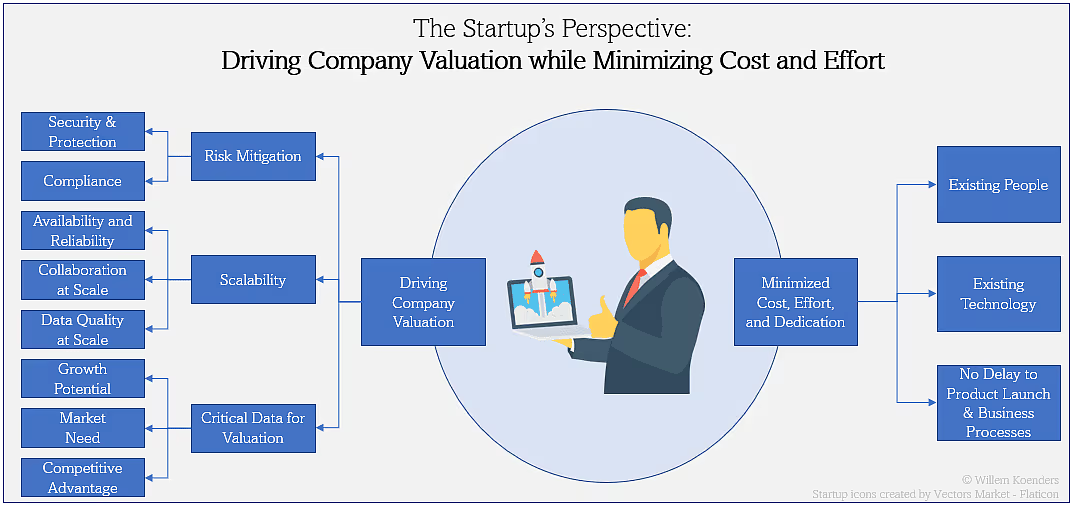Opinion & Analysis
4 Critical Data Strategy Success Factors for State and Local Governments
Key enablers to develop and implement successful data strategies informed by the voices of data leaders across the U.S.
Written by: Tracy Jones | Associate Director, Guidehouse
Updated 2:16 PM UTC, Tue September 17, 2024

State and local government leaders recognize the transformational power of data but often are not aligned on a data strategy and operational plan to effectively leverage opportunities across the enterprise. For instance, although the rise of AI promises transformational impacts, many state and local governments do not have the foundational data capabilities or governance processes in place to successfully embrace AI solutions.
Developing a data strategy and roadmap is a foundational step that state and local leaders can take to align priorities, apply intention, and provide an actionable path to enable mission goals and objectives. Several states, including North Dakota, have successfully developed and are implementing data strategies.
North Dakota Chief Data Officer (CDO) Kim Weis recalls when the atmosphere and data appetite at the state was turning the corner, moving away from looking at data as a byproduct of transactions and toward data as a strategic asset. This momentum and excitement around the potential use and impact of data eventually led to the development of a comprehensive statewide data strategy and implementation roadmap.
When defining a data strategy, it is vital to balance visionary and tactical guidance. An old Japanese proverb says, “Vision without action is a daydream. Action without vision is a nightmare.”
A successful data strategy is twofold: First, it establishes an enduring vision and principles for how data should be managed across the organization. Second, it sets actionable goals and objectives that advance the organization toward its desired future state.
An organization aligned on a data strategy can achieve:
-
Operational efficiencies
-
Cost savings
-
Increased data reliability
-
Reinforced security and compliance
-
New insights and impact from data
-
A workforce empowered to drive citizen outcomes
To enable the development of a successful data strategy, states and localities should consider four key Data Strategy Success Factors (depicted in Figure 1). While these success factors can be applied broadly to other public and private sector organizations, they are especially critical for state and local leaders due to their complex and multifaceted environment.

Data strategy success factor 1 — Business Enablement
The most successful data strategies align with business needs to effectively identify goals and objectives for immediate, emerging (near-term), and long-term organizational priorities. Critical to building business alignment is ensuring leaders and stakeholders speak the same language and have a common understanding of data terms and capabilities through foundational data literacy.
In speaking with North Dakota’s Weis, she emphasized the importance of data literacy, which provides a foundational understanding of data and clarity in the terminology used between business and IT. A data literacy effort can start small, covering the basics, and mature over time to empower staff with the skills and knowledge necessary to perform future capabilities.
Weis recommended minimizing technical jargon when eliciting business needs. “Coming from the IT world, we have our lingo, which can be off-putting and overwhelming for business folks who know their data and what they want to do with it,” she said. “Remove technology from the conversation and focus on business problems and how data can be used to support business needs.”
An additional way to ensure the goals and objectives outlined in a data strategy align with business requirements is by identifying and prioritizing data use cases. The organization can leverage use cases to improve internal operations and mission delivery. A backlog of use cases allows the organization to continue to identify areas of collaboration and address diverse organizational needs from both a technical and mission-delivery perspective.
Traditionally, data use cases focus on how the organization can leverage data products, such as reporting, analytics, and business intelligence, to derive data-driven insights and drive citizen-centric outcomes. With the rapid growth and excitement around AI, exploring transformational AI use cases can build business desire and interest in the data strategy.
These use cases can inform a plan and roadmap for delivery. The plan and roadmap for out-years can be high-level, as priorities and exact timing may change. The focus for the upcoming year should be more detailed, with clear ownership, metrics, and alignment to the budget and other key initiatives.
In North Dakota, Weis has developed a three-year roadmap, including a year-one action plan to direct near-term projects. The action plan also includes tasks that support the data strategy’s direction and goals. The strategy and roadmap’s rollout will align with the state’s budgeting process, which Weis anticipates will support investment and prioritization in key projects to grow statewide data capabilities.
Data strategy success factor 2 — Leadership Commitment
Leadership commitment is critical to enacting and executing an effective data strategy. Ideally, a top-level leader (e.g., governor or mayor) is engaged with focused data priorities and recognizes the importance of data management and innovation to enabling citizen outcomes.
Leadership support can build trust and drive enterprise data strategy development by bringing together multi-departmental organizations or agencies to align data management across domains, authorities, and programs.
In the City of Detroit, a strong collaboration with the mayor has been a critical enabler of data-related initiatives. Chief Information Officer Art Thompson has found that “a successful, unified project needs to start at the top.” To engage leadership, Thompson recommended identifying how data-related initiatives can help accomplish a common goal and mission for the organization.
If top leadership support is not feasible, consider developing an agency or program-level data strategy to provide strategic guidance for data in a specific domain (e.g., education, public health, transportation). In this scenario, an agency or program-level data strategy allows a motivated pocket of the organization to promulgate guidance across its environment. This precedent can become a building block for expansion or the future adoption of an enterprise data strategy.
Currently, the State of Tennessee has no formal CDO office or dedicated role. As such, Chief Evaluation Officer, Dr. Jonathon Attridge works across the state’s 23 cabinet-level agencies to support strategic data analytics efforts and the modernization of data collection and management systems. Through this effort, Attridge has built partnerships and a coalition of the willing on data initiatives that share and analyze data to address specific policy challenges.
Data strategy success factor 3 — Stakeholder Engagement
Continued collaboration, support, and buy-in require engagement with a wide array of business and technology stakeholders throughout the data strategy development process. Thoughtful stakeholder identification and planning improves both strategy quality and buy-in across different business and technology stakeholders.
Begin early engagement with business units that express an appetite for data capability improvements and products. Engagement methods may include but are not limited to, one-on-one interviews, multi-stakeholder listening sessions and workshops, and electronic questionnaires. An open comment period via an online discussion board or crowdsourcing tool can provide a high volume of stakeholders the opportunity to engage in open dialogue regarding strategy components. Additionally, a data strategy working group or steering committee can provide ongoing feedback and stakeholder collaboration opportunities throughout strategy development and implementation.
Leaders should consult stakeholders early and often to obtain perspectives and insights. This helps create a comprehensive strategy that considers priorities, dependencies, and alignment with other strategic actions or projects.
State of Michigan CDO Scott Powell spends significant time meeting regularly with individual departments and stakeholders to understand their data needs and challenges. “Every department has their own circumstance,” Powell said. “We must take the time to learn about those [circumstances] and connect the dots on how data can help them.”
Data touches everyone. So, while it can be tempting to keep a close circle of key stakeholders, it’s important to expand stakeholder engagement to allow for discussion and sharing of different value propositions.
Tennessee’s Jonathon Attridge explained his focus on building relationships at various levels of the organization facilitates a better understanding of how data-related initiatives can meet folks where they are. “Building relationships with the people who are heads-down doing the work has been a key to success,” he said. Intentional relationship-building in Tennessee has created a collaborative environment and a coalition that supports and participates in data-related initiatives.
Data strategy success factor 4 — Expedient and Nimble Mindset
The process for data strategy creation is almost as important as the strategy itself. While applying the first three success factors, it is important to keep in mind expediency and nimbleness.
Expediency draws from Isaac Newton’s Laws of Motion, which states that objects in motion remain in motion and those at rest remain at rest. If a strategy takes too long to build or is interrupted, it will lose momentum and be at risk of getting sidelined by other initiatives, leadership turnover, or general disinterest.
Shorten the strategy development timeline by focusing on a key vision, guiding principles, and high-level goals, and leave more detailed annual operational planning to follow. Annual operational planning can be an extension of the data planning process, allowing state and local leaders the opportunity to prioritize and recalibrate strategic initiatives and appropriately budget resources for the next year.
Nimbleness is growing in importance as the pace of technological change increases. Even two years ago, many could not have predicted the dramatic market shift that generative AI would bring. Other emerging technologies, such as quantum computing, extended reality, and robotics, will likely result in future market upheavals. Since technology and data use are changing before our eyes, strategies must allow organizations to react to change nimbly.
This means having a strategic direction but continuously revisiting the use cases backlog, keeping up with technology trends, and using the annual budget process to realign, coordinate, and fund data initiatives that will enable the organization to move toward its strategic vision.
Additional Data Strategy Resources
State and local government leaders can apply the four Data Strategy Success Factors to begin defining successful and executable data strategies. However, these best practices are just a start. The state and local government landscape is unique and complex. As such, look for opportunities to connect and collaborate with other leaders to share best practices and lessons learned. Consider best-in-class resources and networks such as the Bloomberg Philanthropies City Data Alliance and Georgetown University Beeck Center State Chief Data Officers Network.
About the authors:
Tracy Jones is an Associate Director in Guidehouse’s Data & AI Practice. She has 15+ years of experience with federal, state, local, and utilities/energy in the areas of data strategy and management, enterprise change management, product visioning, and professional advisory services. She supported the development of the Federal Data Strategy, 2020 Action Plan, and the Federal Data Ethics Framework.
Cassidy Solomon is Senior Consultant in Guidehouse’s Data & AI Practice. She is a Certified Data Management Professional (CDMP), with hands-on experience supporting public sector clients with data strategy, data governance, and data management maturity assessments.


